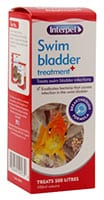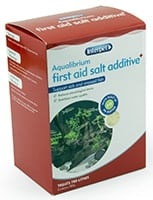
Your discus swimming face down is a sign that your fish have a buoyancy issue or simply put the loss of balance. That means your fish has lost the ability to swim properly. This issue could be caused by either stress or an abnormality in your discus fish swim bladder known as swim bladder disease or disorder.
Table of Contents
- How Does A Swim Bladder Work In Fish?
- Swim Bladder Symptoms
- Swim Bladder Details And Causes
- Swim Bladder Treatment Steps
- Future Preventive Tips
- Conclusion
It can sometimes be disturbing to see your discus fish swimming face down and not knowing the reason. In this article, you would learn the reason your fish is swimming face down and more; possible treatment, so keep reading.
How Does A Swim Bladder Work In Fish?
A swim bladder in your fish helps it stays stable in water and controls the direction it floats in. To swim upward, the discus fish would have to inhale, thereby filling its swim bladder with air. That’ll make the Discus buoyant and float towards the surface. It then releases air from its swim bladder to swim downwards. You could notice this process by looking out for bubbles coming out from its mouth.
Physical defects which will eventually lead to difficulty in swimming is a major effect of the swim bladder. If you want to save your pet from discomfort and possibly death, you should act swiftly. Because early detection is key. Look out for these symptoms, if you notice any form of instability.
Swim Bladder Symptoms
- Struggle with maintaining balance.
- Swollen belly.
- Scales sticking out rather than lying flat.
- Floating upside down, face down or one side.
- Buoyancy either positive (floating on the surface) or negative (lying at the bottom of the tank).
Swim Bladder Details And Causes
Swim bladder disease is a prevalent disease that affects aquarium fish, including discus. Rather than being a disease, swim bladder disease is actually a symptom that could have different causes. The swim bladder disease is more of a disorder.
Is Swim Bladder Disease Contagious?
Swim bladder disease is not contagious in itself. However, if it’s a symptom of an infection, the other fish may get infected by it. This makes it contagious by association. Other fish may get infected if they remain in the tank and under the same living conditions.
There’re various causes of a swim bladder disorder. And to successfully treat your aquarium fish, you need to be able to know the particular reason your Discus fish is swimming face down. It could be caused by either a temporary or permanent defect to the swim bladder. The result of this would be the loss of ability for your fish to balance its body while swimming. Below are some of the causes of swim bladder disorder:
Physical Or Mechanical Trauma
This is an example of a swim bladder malfunction caused by the permanent deformation of the swim bladder. Swim bladder can be caused by:
- A hard impact, such as dropping the fish after maintenance.
- A fight with other fish.
- The fish hitting itself on an object.
Birth Defect
Discus fish like other fish are sometimes born with a swim bladder disorder. It’s difficult to manage and often incurable. Although swim bladder disorder is not contagious, it is genetic. So, avoid breeding with fish that have this defect.
Infection
Bacteria and parasites are the predominant causes of infections in an aquarium. And since swim bladder disease could be an effect or symptom of an infection, it becomes contagious to fellow fish.
Other Causes
Swim bladder disease can be caused when the bladder is compressed by other organs. And there are several causes of compression. These include:
- A fish inhaling too much air in the process of eating floating feed. This would lead to bloated belly and distortion thereby cause your fish to lose balance.
- Cyst infection resulting in the enlargement of the kidney.
- Too much food (overfeeding), which could lead to stomach enlargement and water contamination.
- Leftovers dissolve into ammonia suitable for the striving of bacteria. This will also increase the nitrate level in the tank.
- Eating food that expands or ferment in their stomach leading to bloating.
- Constipation due to slow digestion, which could be a result of cold temperature, eating too fast, or overfeeding.
- Sudden temperature change.
Low Water Quality
This could be a result of fish waste and feed leftovers that sank to the bottom of the tank. These dissolve into ammonia. And the ammonia then converts to nitrites (NO2), which then become nitrates (NO3).
Swim Bladder Treatment Steps
- Ensure to have a test kit in your store.
- When you observe an unusual movement, remove the fish from a regular tank to a hospital tank if the tank contains more fish. The reason for this is so that you won’t have to worry about treatment affecting fellow habitants.
- I recommend you keep the volume of water low. This will help your fish get balance and move around easily and with less energy.
- Maintain the temperature of the water in the tank at around 86º degrees Fahrenheit all through the treatment process.
- Ensure to remove your fish from the tank during water cycling.
- To relieve your fish from stress, add one teaspoon of aquarium salt per 10 gallons to the water in the tank.
Other Treatments for Different Conditions
Treatment For Constipation Or Bloating
To treat swim bladder disorder under this condition, I recommend two methods. Although both methods could be used together. First:
- Feed your fish with food that is rich in fiber; Pea’s a good example. The fiber in the feed would aid the digestive system of your fish to excrete whatever is undigested.
- Boil the pea but make certain not to overcook it.
- Peel off the skin and then soak in water. This does avoid complications from swallowing and expansion of pea in the stomach of your fish, respectively.
- Make use of shallow containers so make cleaning easy when the pea sinks to the bottom.
- As a result of weakness and also to reduce stress on your fish, you may need to hand-feed them.
- Then don’t feed in the next 24 hours to allow the fibers to clean your fish’s digestive system.
Second, especially in case of loss of appetite:
- Once you confirm your fish have swim bladder disorder, don’t feed for at least three days. Fast your fish.
- During the fasting, maintain a temperature of about 86 degrees Fahrenheit. This way, your fish would have the right level of body heat necessary for digestion.
- After the three days of fasting, feed your feed with preferably cooked and soft feed in a tiny quantity.
- You may also need to gently hand-feed your fish to avoid stressing it.
Treatment For Bacterial Or Parasite Infection
- To be sure it’s a bacterial or parasite infection, look out for additional symptoms such as body spots, clamped fins, body shaking, and/or reduced appetite.
- Most times, bacterial infections result in fluid filling the bladder.
- And if there is fluid in the bladder, then you need to what bacterial is causing the infection.
- After determining the bacterial responsible, commence treatment immediately because delay might result in death.
- A proper antibiotic can be applied. For example, swim bladder treatment combined with equilibrium first aid salt additive should be used.


Treatment For Nitrate Poisoning
- I recommend you use a liquid test to check the level of nitrate in your tank. It is because they are more accurate compared to test strips.
- Carry out an immediate water change up to 40% of tank water or bring the water down. Although this is entirely dependent on the nitrate level.
- Go ahead to remove only 5% to 10% of water per hour. So that you won’t cause an imbalance in the pressure. Because it could cause swollen organs and a swim bladder malfunction.
- Regularly change and rinse the aquarium’s filter because gunk could build up and cause nitrate poisoning.
Future Preventive Tips
To ensure that your Discus doesn’t suffer swim bladder disorder again in the future, begin to do the following tips:
- Always keep a toolkit around.
- Always keep around equilibrium first aid salt additive.
- Don’t overfeed. Fish will continue to eat as the feed keeps coming. However, this may lead to a bloated stomach compressing the swim bladder. Also, leftovers could contaminate the aquarium.
- The floating feed should be avoided. (This would cause your fish to gulp too much air while eating.)
- Feed your fish with sinking feed.
- You could soak feed before use. (This prevents food expansion in the belly of your fish. Because the feed would already expand inside the water.)
- Carry out a regular water change. (This ensures the nitrate level in the tank is regulated. Hence preventing swim bladder disorder.)
- Use a large filter. (Bigger filters allow more leftovers.)
- Regulate water temperature. (The metabolism of fish is mostly affected by their body’s temperature. Hence, when they are in cold water, their digestive ability is slowed down. And this could lead to constipation.)
- Feed your fish with high-fiber feeds from time to time. You could this once a week.
- Ensure that frozen feeds are fully thawed before giving then to your fish.
- You should feed bloodworms to your fish once in a while. (Not a frozen blood worms)
Conclusion
So now you know, if you see your Discus swimming face down it a sign your fish has swim bladder disease or disorder. It doesn’t have to be a death sentence. But early detection is key to nursing your fish back to health. Except in the cases of defects. So, if your fish already has the disease swing into action with the treatment methods above. And if not, the preventive tips would ensure your fish never go through the discomfort associated with the disease and possibly death.


hi
my discus fish swim upside down for months.
Others don’t.
I think infection should be ruled out.
What do you think.
There are many factors that could be the reason for your fish to swim upside down, one of the factors is bad water quality, put in your mind that Discus fish are very sensitive, so if you have them together with another type of fishes, you might not see any symptoms on the other fishes if the water parameters are not perfect.